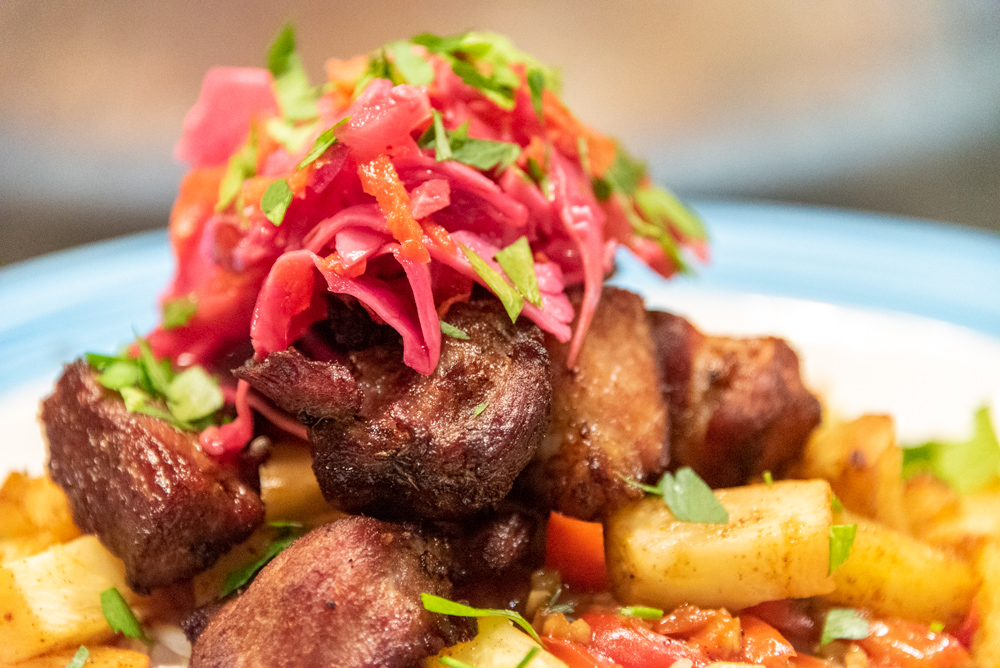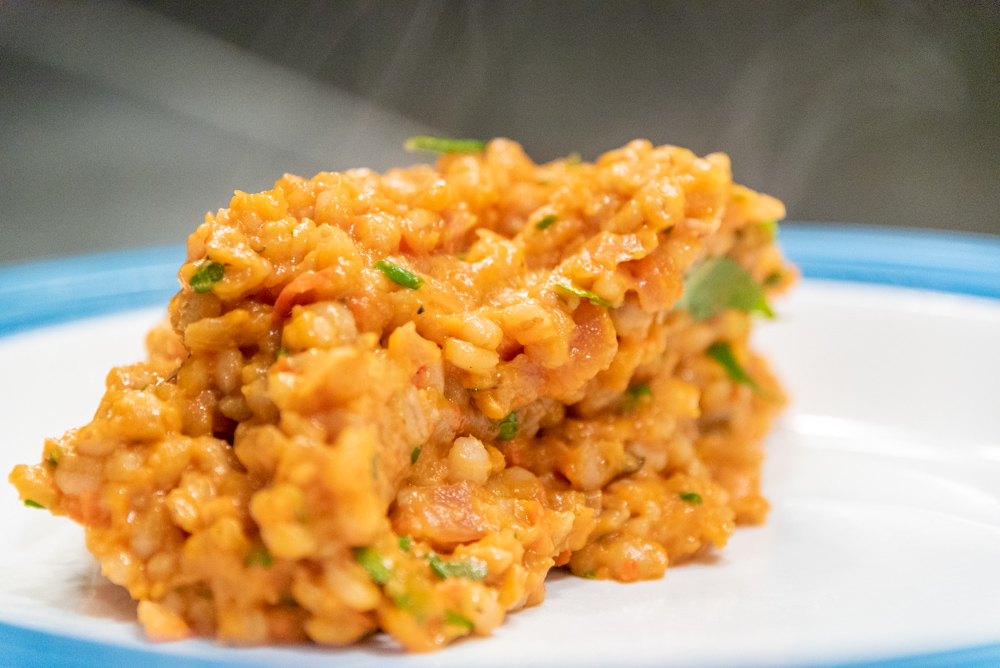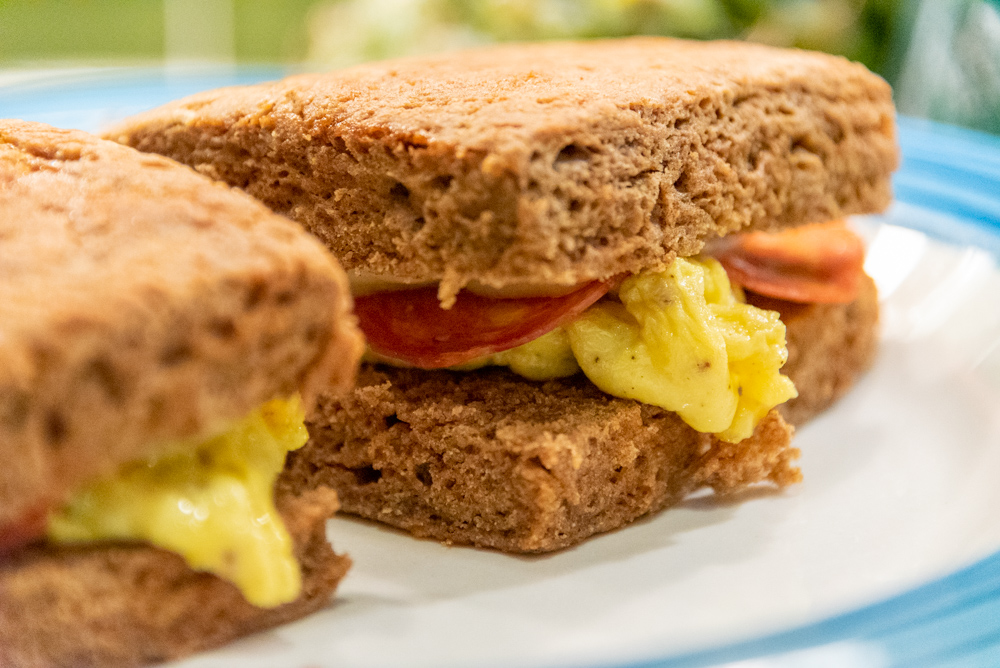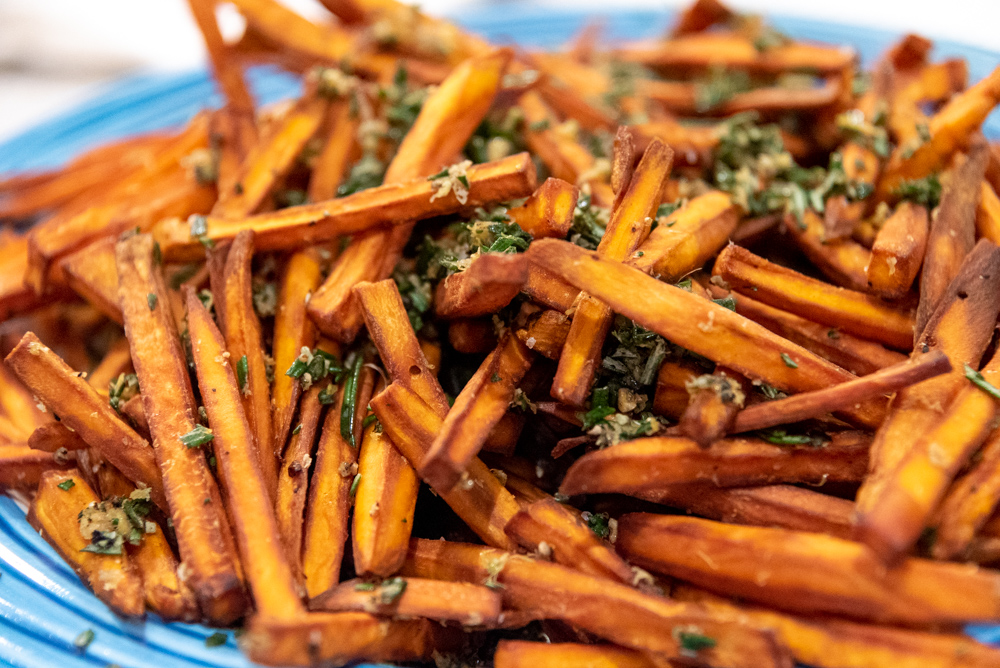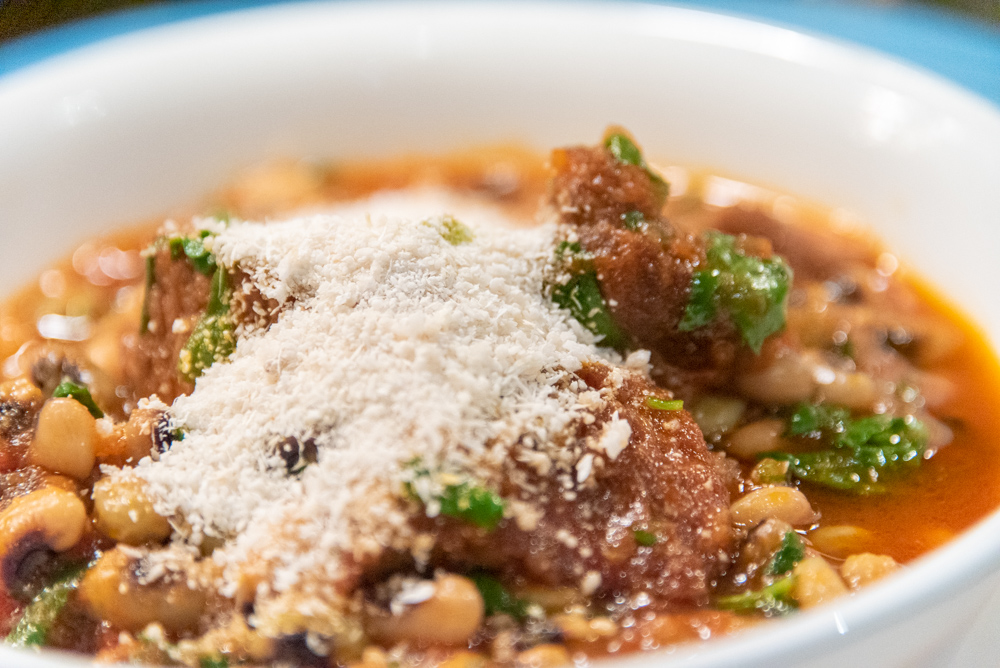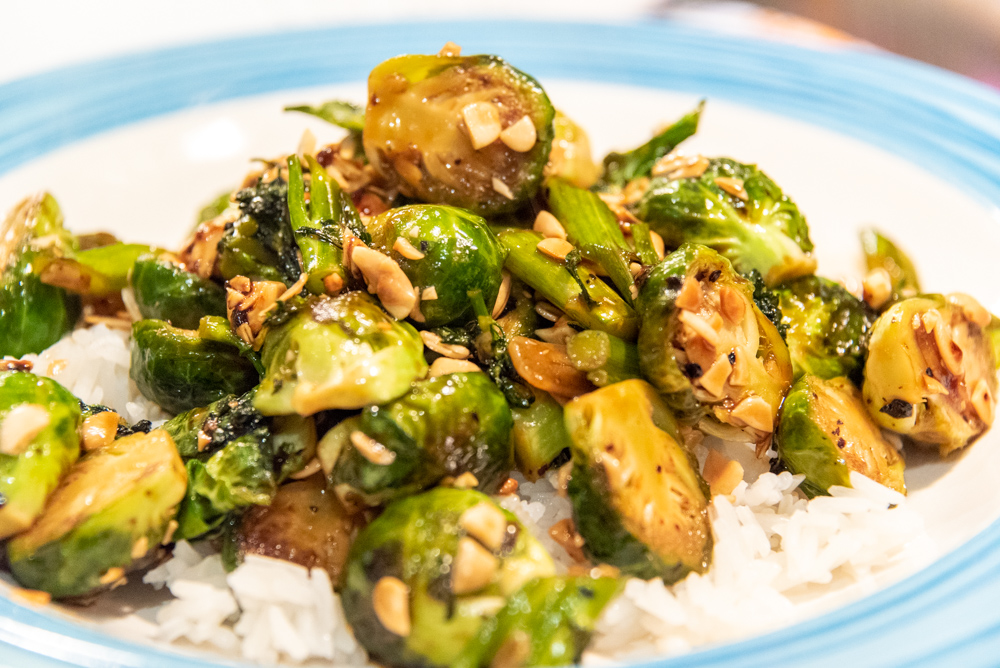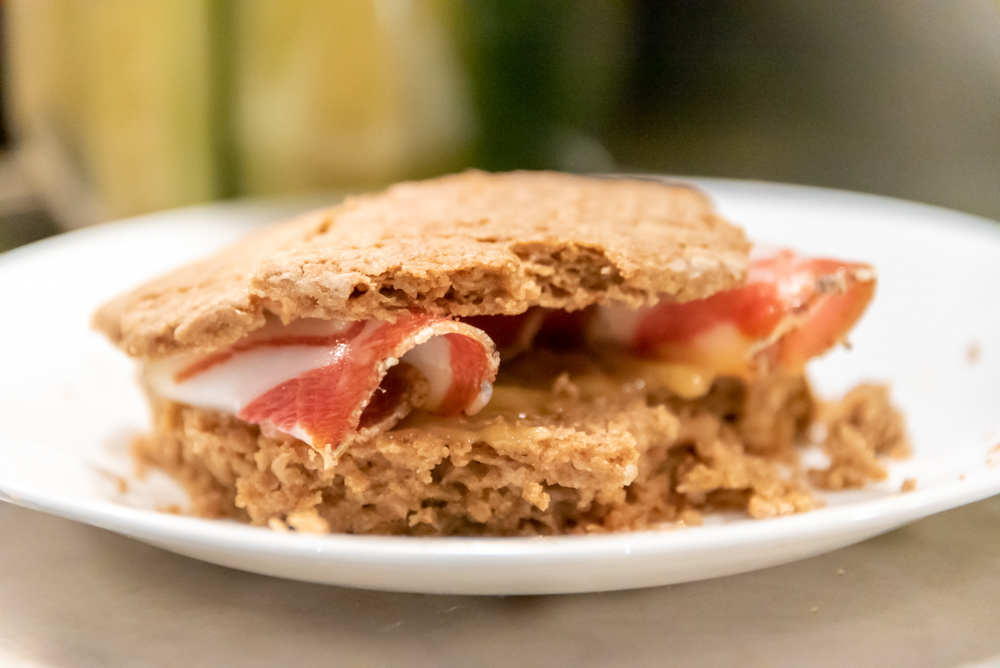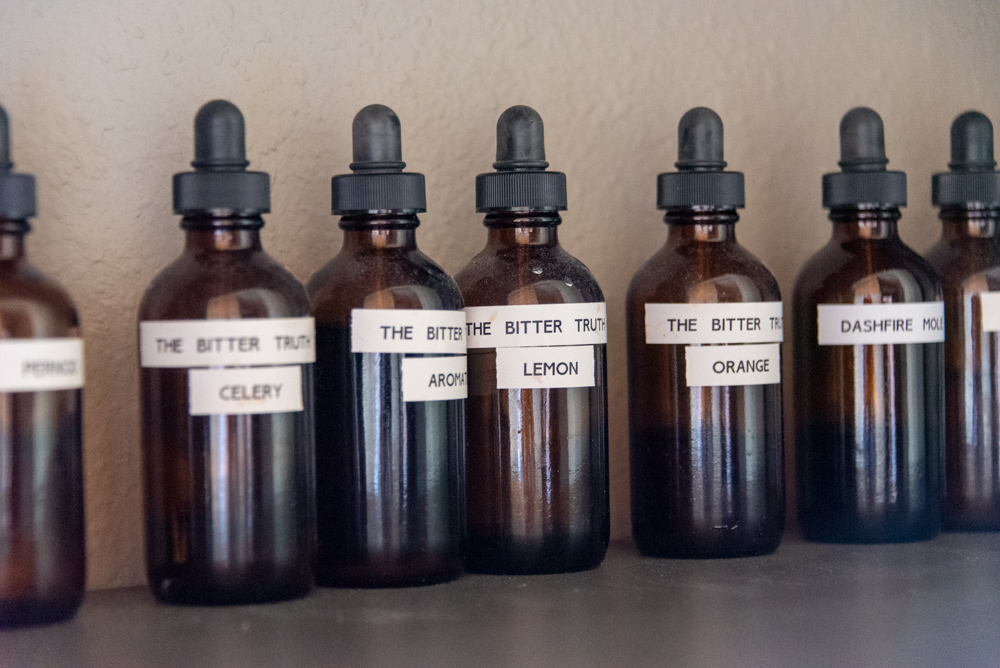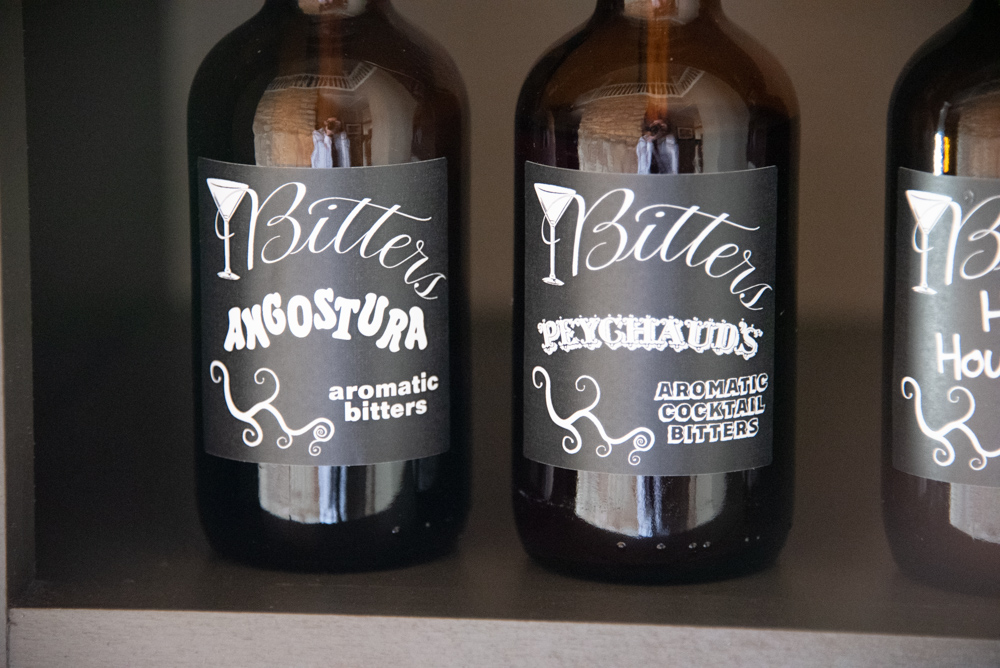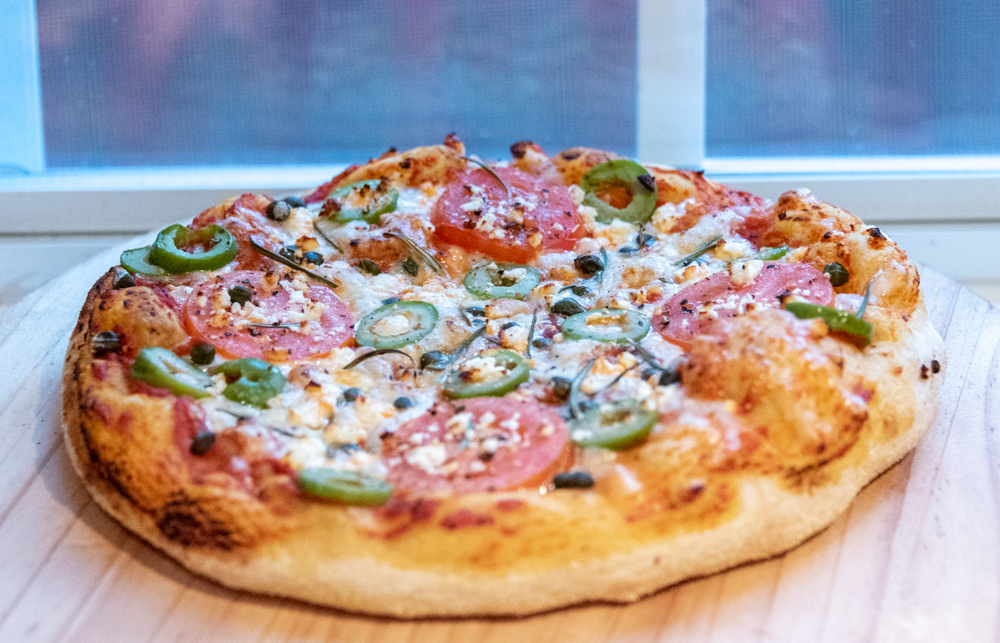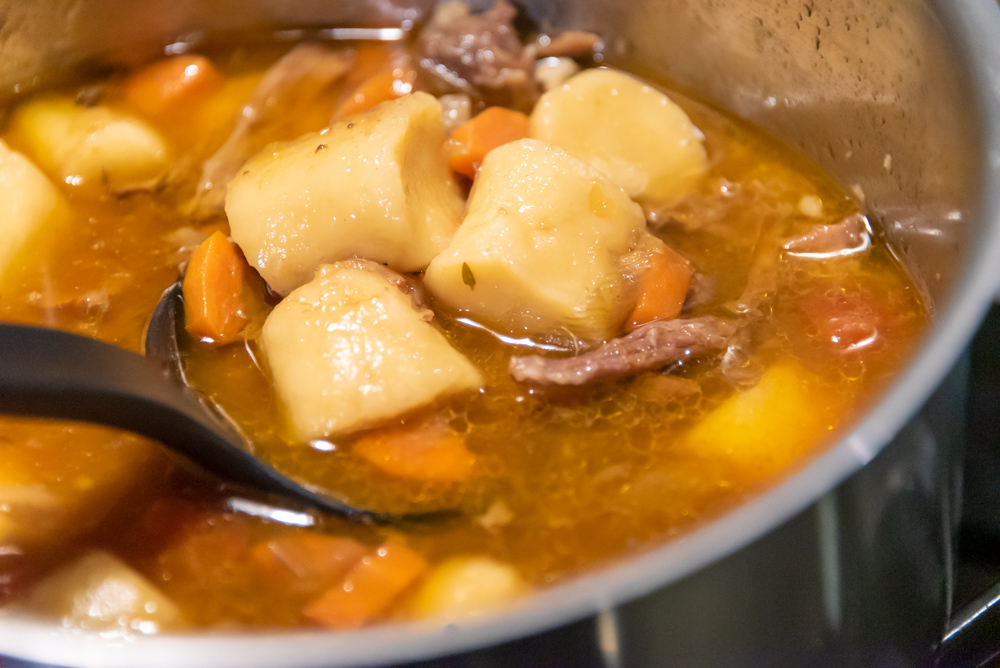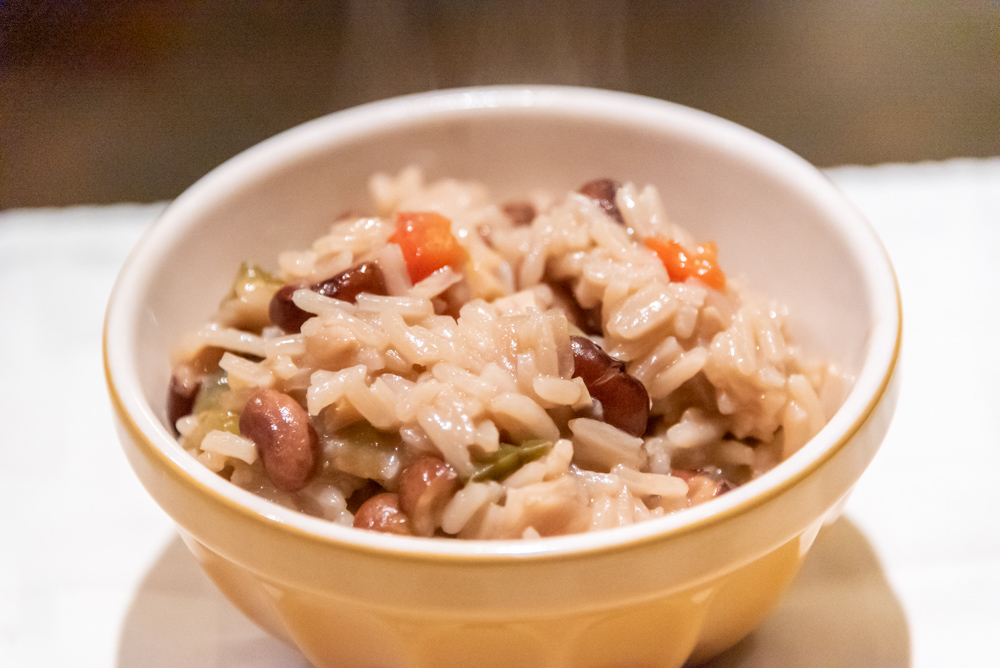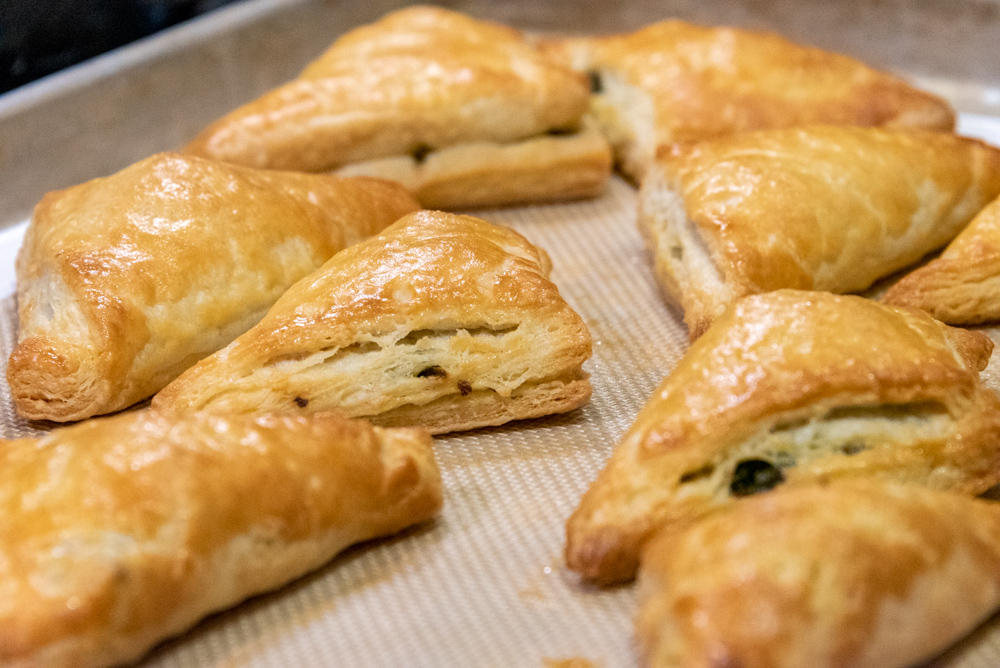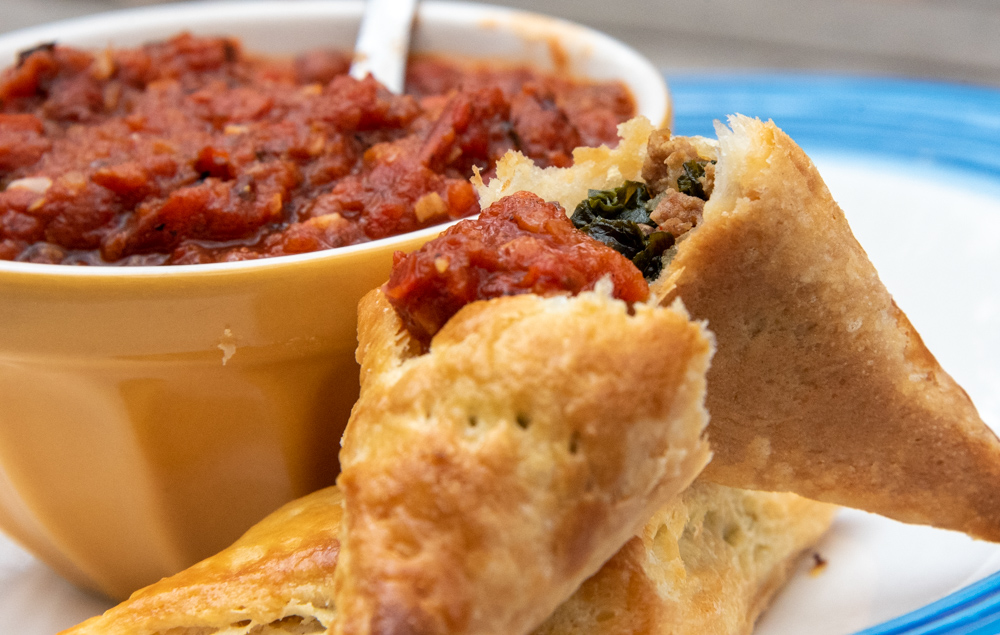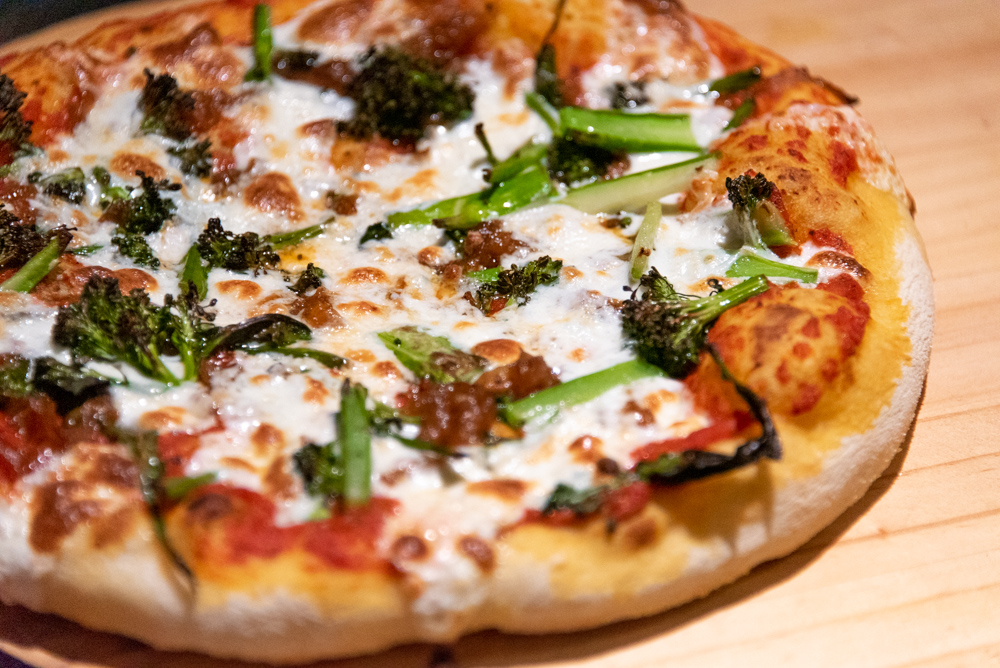-
Posts
10,190 -
Joined
-
Last visited
Content Type
Profiles
Forums
Store
Help Articles
Everything posted by Chris Hennes
-
Pork Griot with Roasted Pineapple and Pikliz (p. 30) This was spectacular. It probably would have been even if I had followed the recipe . Let me explain... There are four components to this dish: "pikliz," a quick-pickled cabbage, carrot, and cauliflower mixture, used as a topping. "Vegetables," which in this case means red bell peppers sauteed with garlic, ginger, and habanero and then sauced with orange juice, Worcestershire, and blonde miso. "Pineapple," which is a roasted pineapple spiced with brown sugar, chili powder and cumin. And the pork shoulder, which the recipe has you cube and then marinate in orange juice, allspice, thyme, black pepper, and garlic for six hours before roasting at 250°F for a couple of hours to cook. Most components I left alone, but I bought the pork on Saturday morning from a local farmer, and I didn't want to leave it raw in the fridge all week while the pikliz pickled (piklizzed?). So instead of slow-roasting the pork in the oven, I dumped the pork and marinade in a vacuum pouch and cooked it sous vide for 36 hours at 65°C, then chilled it. That way it would keep until the pikliz were ready, which took until Thursday (today). To serve the dish you make the vegetable and pineapple components, then deep fry the pork until the chunks are browned and crispy, then mix it all together and serve with the pikliz on top. I thought the ingredients looked too good on their own to mix together before plating, so I left them distinct and only mixed while eating. The big advantage of that deep frying step is that it is the perfect finish to the sous vided pork chunks, getting them nice and browned and crispy, while leaving the interior perfectly cooked. I'm sure it would have been good with the pork roasted in the oven instead, this was just more convenient for me, timing-wise. These are big flavors here, layered with a lot of complexity. The balance is excellent, and really my only complaint is that for a dish that uses three habaneros, there wasn't actually that much heat. Well, that and the fact that there are like eighty six steps and four hundred ingredients. (That might be a slight exaggeration...) It was fun to make and turned out great.
-
Farro in Jollof Sauce (p. 260) Another recipe that sounds deceptively simple, but actually involves a number of steps to build up a surprisingly complex and well-balanced flavor. I say surprisingly just because the ingredients list is not particularly exotic---it doesn't call for any of the various sauces, butters, spices, etc. that many of the other recipes do. The farro is cooked relatively conventionally first. Then a sauce of red onion, red bell pepper, tomato, garlic, and habanero is prepared: the ingredients are blended together, some onion is sauteed separately, then the sauce is added to the pan and cooked down until it begins to darken. The farro and a large quantity of thyme is added, then some of the farro cooking liquid is used in the style of a risotto, adding a bit and stirring until it's been absorbed, then adding more, etc. Finally, monter au beurre and stir in parsley and scallions (I used chives). The result is a delicious dish with a texture similar to risotto, quite a bit of heat, and a good flavor complexity. It was a bit involved, but the end result was worth it. (ETA: The recipe is from Pierre Thiam)
-
I love biscuits, so it's no surprise that I'm having another go at the Teff and Brown Butter Biscuits I posted about earlier. I think that recipe has a few flaws: first and most obviously, it's too salty. I'm guessing that they swapped teaspoons for tablespoons (<soapbox>another sad entry in a long line of problems that wouldn't have occurred if they'd used weights instead!</soapbox>). So the recipe had three times as much salt as it should. Tonight I swapped them back. Definitely the right choice. Second, the biscuits were actually too tender! They couldn't hold together enough for you to actually eat them with the country ham. Tonight I swapped out half the cake flour for all purpose, and was a bit less gentle with the dough as I was forming it. Another success: they are still tender, but have enough structure to eat with your hands. Third, I think the recipe is designed for a much larger batch size, so you end up with a sheet pan full of octagonal biscuits (you don't space them in the pan, so the circles merge). With a smaller batch size that doesn't really work. They sort of smoosh out at the edges, and only one or two in the middle really have proper support and get their full rise. So I cut square biscuits and baked them in a loaf pan that was just big enough to hold them. This gave them more vertical structure, and better rise. I'm sure an alternative is to just make more biscuits, but there are only two of us eating them. So a half batch split between us is about right. Tonight I served them as a sausage (well, Calabrese salami), egg and cheese sandwich. I like them - they are an interesting addition to my biscuit repertoire (Eat Your Books says I have 51 savory biscuit recipes now).
-
Bullock Fries (p. 182) This sweet potato fry recipe is from Joe Stinchcomb, and named for St. Louis bartender Tom Bullock, who wrote the 1917 mixology book The Ideal Bartender. The spice mix is garlic, rosemary, and lemon zest. I got impatient and overcrowded my fryer, so these didn't end up as crispy as I would have liked, but the spice mixture is delicious: the lemon zest gives it an unusual pop that I really enjoyed.
-
Pork and Beans with Piri Piri Sauce (p. 113) This is a twist on BBQ pork and beans, using a piri piri sauce instead of a sweeter, molasses-based recipe. That sauce is onion, garlic, habanero, crushed tomatoes, vegetable stock, and red palm oil. At the end you add a couple of cups of greens (I used arugula) and top it with garri, which is dried fermented cassava. This was very good, with a long, lingering heat from the habanero, and a nice texture from the garri. I think I'd have liked it better with a bolder green (the recipe suggests collards, kale, or mustard), and probably more of it, but overall a definite success.
-
I'm in the midst of making a couple of the pork dishes from the book, and I just read the recipe intro for a recipe called something like "Roasted Pork with Pikliz." In the intro it is suggested that you should make the pikliz while the pork is roasting in the oven. Except the pikliz are a quick pickle that have a three day rest in the fridge. That would be a LONG roast! I think maybe whoever wrote the little intro blurb was unclear on what, exactly, the recipe was for. Of course, if you were to sous vide the pork instead of roasting it... so that's actually what I'm doing. I think this will work out fine, since the pork actually gets deep fried right before serving anyway. Also, I'm not actually ready for this dish yet, I'm missing some ingredients. So I'm going to SV and chill the pork and make the final dish later this week. By which time the pikliz will be ready to go.
-
You're right - balance was key in this one, I definitely measured all of the ingredients (though I find that to be true with anything involving fish sauce). The flavors worked well together, though as usual I'd probably prefer it a bit less sweet. I suspect I'd have liked it better without the honey, but that won't be universal. I did find that the broccolini got a little lost by the end.
-
Brussels and Dry Shrimp (p. 62) From the title I expected this recipe to resemble something from Fuchsia Dunlop's books (she's got a cabbage and dried shrimp stir fry, for example), but I should have known better: there is no resemblance. The "dry shrimp" in this case refers to fermented shrimp paste, not to the dried shrimp I was familiar with. The dish is sauteed brussels sprouts and broccolini with a sauce of fermented shrimp paste, soy sauce, rice wine vinegar, honey, fish sauce, and Urfa pepper flakes, tossed with peanuts and egusi seeds. The shrimp paste is definitely the dominant flavor here, though the egusi seeds have a pretty distinct flavor if you get a bite with a lot of them in there.
-
It seems appropriate the bump this topic back up here on Thanksgiving 2020 -- since many of us are doing a digital Thanksgiving anyway, there should be plenty of opportunity to post photos of today's roasting activities. Surely someone out there is still actually roasting a turkey today...
-
I really (really) like the Dashfire Mole bitters bottle, but I think Fee Bros bottles are ugly. If there was only one Fee Bros. bottle that would be fine, it would just blend into the crowd, but there are six or seven of them, I think.
-
I'm still torn on the color issue: the shelves are gray and the walls are grayish. About half the stuff that's intended to live on these shelves is either clear or very desaturated. But the other half (cookbooks, plants, etc.) is pretty saturated, and the art on the walls is (or will be) saturated. I don't think I'll be able to tell until the lighting is installed whether these should be colored or not. Of course I am a librarian: they are in alphabetical order, so finding the right one is not too bad.
-
It seems to me that you've answered your own question! From the recipe description: "this recipe is where Ethiopia meets the South."
-
"Why" for which thing? There are a couple of paragraphs of intro, but no extensive profile of Ali.
-
Teff and Brown Butter Biscuits with Shaved Country Ham (p. 266) From Roblé Ali comes this unusual biscuit recipe. You begin by making brown butter, which then serves as half the butter in a biscuit that's 50% Teff and 50% cake flour. Like all biscuit recipes this one cautions against overworking the dough, but with so little gluten-forming ability in that flour combination I think actually a little kneading, or at least some folds, would have been beneficial. You serve them by slathering on sorghum butter (just a compound butter with sorghum), then top with country ham, and serve as a sort of sandwich. But they are so tender that they crumble apart when you bite into them: the biscuits don't stand a chance against the much firmer ham. I also think the recipe has an ingredient typo in it: it calls for 1.5 tablespoons of salt (to about four cups of flour) -- I'm betting that was supposed to be teaspoons, these were pretty salty, even before adding the ham! So, they were delicious, but I am going to make some changes next time I make them. (For the record, I served with a homemade coppa, rather than country ham).
-
Yeah, the taste was good. I don't know that I'd really want to alter it with hot sauce, the flavors were well-balanced: it is just a relatively sweet dish (there's quite a bit of brown sugar in it).
-
For years, now, I've kept my bitters in those little dropper bottles from Specialty Bottle: the Amber Boston Rounds in the four ounce size, with the black dropper. For the labels, I just used my label maker, so they ended up looking like this: Fast forward to a couple of years ago, when I bought my current house. It's a little weird (designed by a local architect), and has this borderline-unusable space off the dining room. The furniture-designer in me immediately started plotting built-in wine and liquor storage, and the time has finally come to implement that scheme. I've more or less finished building the furniture (I have an electrician coming next month to run some new lines for me, but the construction is done). There is one section above the window that is a very short shelf, about 6" tall, but 5'8" long. My thought was to put my bitters bottles up there, but I decided I wanted something less ugly. My first thought was to laser-engrave the bottles: I was imagining this like laser-etched polycarbonate, where if you edge-light it the etched part catches the light and glows. So I was hoping to uplight the bottles and get a cool glowing effect. Alas, glass doesn't work like that, and the laser-etched bottles are pretty nearly unreadable. Here's the Angostura attempt for reference: So, I went to plan B instead, and picked up some of those waterproof Avery labels in the 2" square size (eG-friendly Amazon.com link). I then spent the day perusing manufacturers websites and pulling logos and graphics from them. Then I created a basic template with my "house label" and morphed the original bottle designs onto that. Here's the result: Once I get the lighting set up in that area I'll post them on their actual shelf, but overall the effect is pretty good. The labels are quite readable, even the Bitter Truth ones, which have the smallest flavor font.
- 14 replies
-
- 10
-

-

-
I forgot all about this one until I was cleaning off my camera's SD card tonight: I had a fresh tomato from one of my colleague's kids, so went with olives, capers, rosemary, mozzarella, feta, and said tomato. The crust was a couple-day-aged Modernist Neapolitan with Caputo red.
- 492 replies
-
- 11
-

-

-
Oxtail Pepperpot with Dumplings (p. 51) I sat down to post this last night, and was literally typing in the title of the recipe when I realized that I had forgotten to make the dumplings. You add them at the end of a long braise, and they totally slipped my mind. So, take two: the recipe in fact suggests making this a day ahead and letting it sit overnight, so let's just pretend I did this all on purpose. Tonight, I made the dumplings and served the other half of the pepperpot (along with some of the rice and peas from last night's post). The dumplings were quite firm: the dough was a bit difficult to work with, in the end I regret not adding a bit more water to make them a little softer. I don't know if this firmness was intentional, or if there was a mistake in the recipe, or if it was user error. Maybe some combination of all three . At any rate, the braise is delicious, if a little on the sweet side for my tastes.
-
Rice and Peas (p. 53) This dish is is from Chef Tavel Bristol-Joseph of Emmer & Rye in Austin. It was designed to accompany his Oxtail Pepperpot with Dumplings. And it almost did! I'll post about the oxtail tomorrow, I totally forgot to make the accompanying dumplings tonight. Whoops. But anyway, for the rice and "peas" (really beans) I used Rancho Gordo Moro beans, rather than the "red beans" the recipe calls for: otherwise I followed the recipe. I should mention that it says it serves six to eight, but I can't imagine eating that much of it when served with the pepperpot. I'd say it serves more like 16-20 as a side. It has a little bit of heat from a single habanero (to 2 1/4 cups uncooked rice), and this time I did leave the seeds in, but frankly it could have used a little more heat. So next time maybe double up the pepper amount. Otherwise, this was a nicely flavored version of the dish, with a lot of subtle background flavors lurking behind the dominant coconut note.
-
I was browsing our New Books shelf at work a few weeks ago and there was a copy of Rose's Ice Cream Bliss -- it's not quite ice cream season here, but I couldn't resist. So I found a thematic recipe to make, instead:
-
Flaky Andouille and Callaloo Hand Pies with Red Pepper Sambal (p. 87) This recipe was not what I was planning to make next, but the turnips at the farmer's market this morning had stunning greens, and I thought they'd make a great substitute for the callaloo (taro or amaranth leaves, which I don't have on hand, surprisingly 🙄). This recipe's complication is that it calls for a homemade roasted red pepper sambal as a dip for the pies. So although the core recipe has a dozen ingredients in it, you also need dozen more for the sambal, and you have to plan ahead to make it. Also, there is a sneaky line item of "roasted garlic" in the ingredients list. Not a huge deal, but something to watch out for. Of course, I figured this recipe actually wasn't complicated enough (truthfully, I was looking for a cooking project for the afternoon). I really enjoy making puff pastry, and have been meaning to try out Julia Child's Quick Puff Pastry recipe for years. So instead of using the store-bought pastry the recipe calls for, I broke out Mastering the Art and gave that recipe a shot. These are delicious. First, of course, there is a crap ton of butter in there---the pastry is great. The turnip greens worked well in the filling, and I really enjoyed the strong cumin flavor and the hint of coconut. The Sambal is also very good, though I wish hadn't seeded the habanero (the recipe doesn't call for it, but I'm a coward).
- 71 replies
-
- 12
-

-
I got my copy of The Rise: Black Cooks and the Soul of American Food (eG-friendly Amazon.com link) a week or so ago: it's an interesting book in some ways more for what it is not: it's not a "Soul Food" or "Southern" cookbook, in the vein of Edna Lewis. In The Rise, Samuelsson presents recipes from dozens of Black chefs across the country, with recipes ranging from Eric Gestel's Chicken Liver Mousse with Croissants (yes, the book has a recipe for croissants) to Kwame Onwauchi's Braised Goat Shoulder with Locust Bean and Chili Oil. The recipes are intimidating. There is not a lot of "simple" food here -- everything is "cheffed up," and Samuelsson does not appear to have dumbed the recipes down for the home cook. Be prepared to scrounge for ingredients, and to spend some time putting together various stocks, sauces, marinades, rubs, etc. If a recipe looks straightforward, look closer: you probably missed the step that said "oh by the way, make homemade sambal" etc. So we are not talking about Modernist Cuisine-levels of crazy here: it's just not "30 Minute Meals," either. The first thing I made from the book was Lagos Plantains with Yaji Dip, from Chef Edouardo Jordan. It was the simplest recipe in the book: I made a video for the library about that one:
- 71 replies
-
- 11
-

-

-

Baking with Myhrvold's "Modernist Bread: The Art and Science"
Chris Hennes replied to a topic in Pastry & Baking
I follow the book recipe exactly, though I ignore the time they give for baking to set the lye: I just bake until they look right. The evenness I think is just a function of how you dip them, and how you handle them (or don't handle them) coming out of the dip. -

Request for Help: New Bread Machine, Metric settings
Chris Hennes replied to a topic in Pastry & Baking
If you are using recipes that use imperial measurements and are set up to give you a 1lb loaf, just treat those (for the purposes of your machine's timings) as though they were a 0.5kg loaf. Although when baking with things like chemical leaveners precision is very important (e.g. cakes, etc.) for bread, you have a ton of flexibility, and it's not like your loaf is going to go off the rails if you are off a few percent in the hydration, etc. So while I concur with @shain and @liuzhou that your best bet is to eventually migrate to weights (and metric, if only for simplicity!), for converting old recipes don't worry too much. 454g is close enough to 500g that your bread will turn out fine. -
Inspired by one of the calzone fillings in Modernist Bread, this is broccolini, caramelized onion, and mozzarella. The crust is a 100% Caputo (red bag), Modernist Neapolitan recipe, but no overnight ageing (not counting the poolish).


